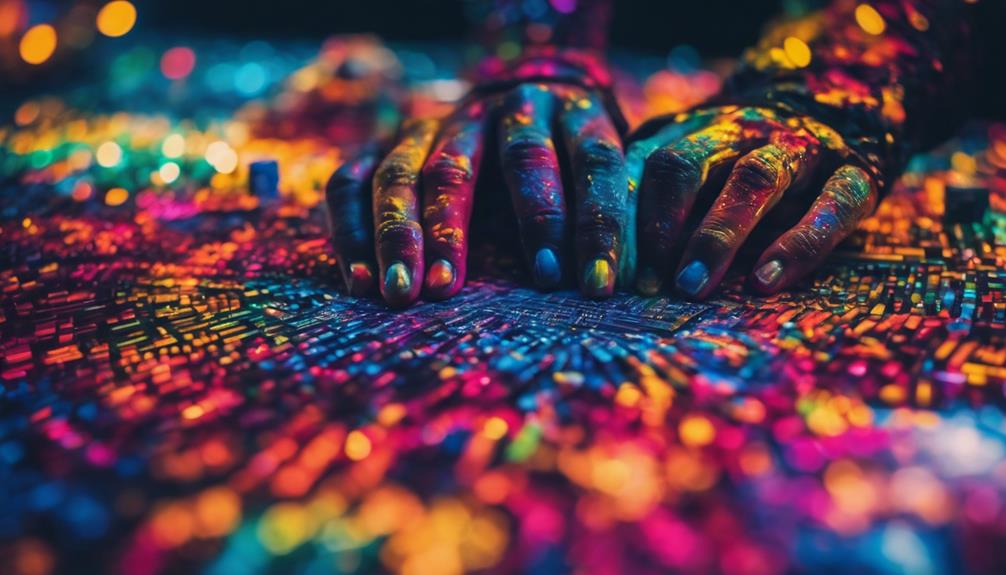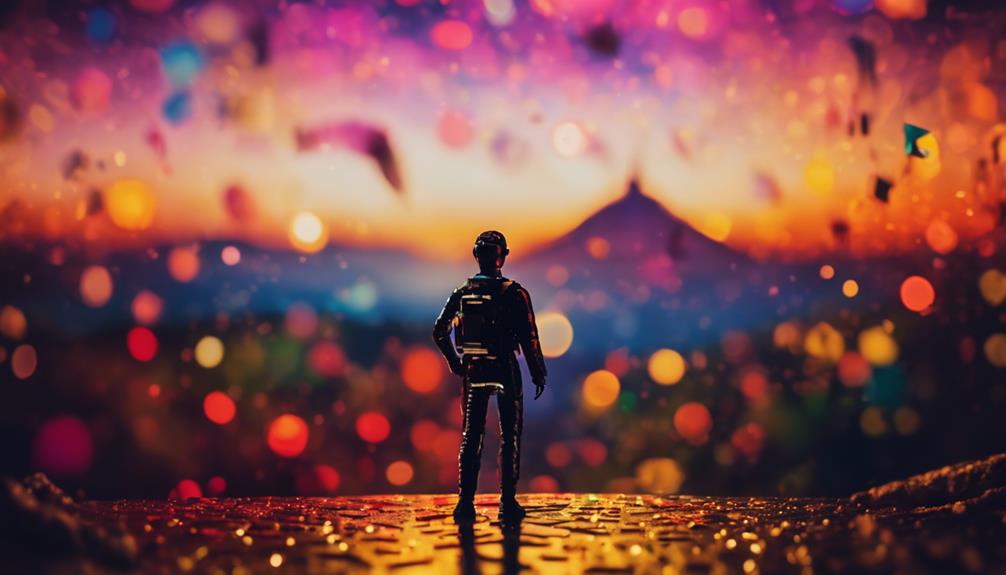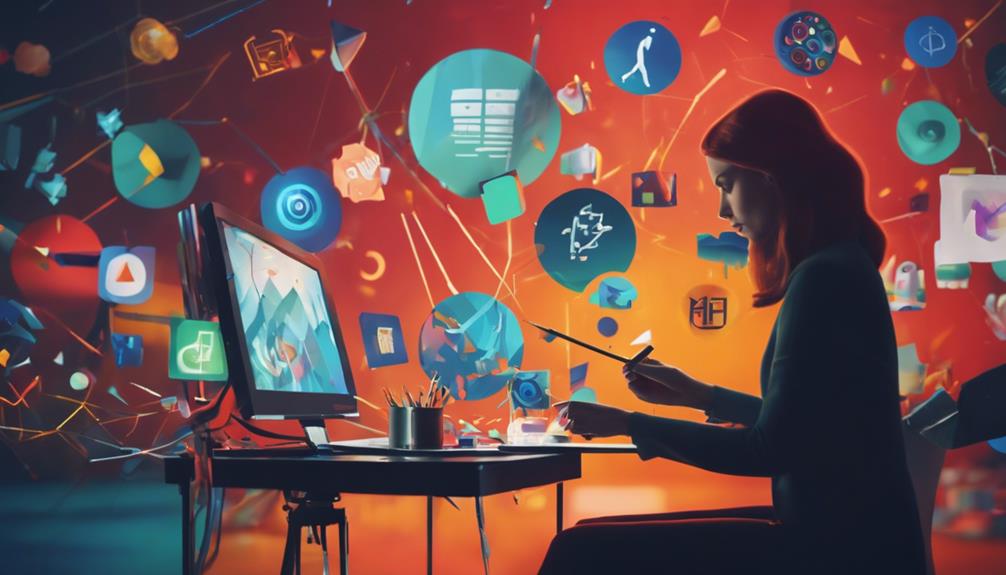Creating AI Art Easily: No-Cost Tools
Introducing free tools for creating AI art is a big step in making digital creativity accessible to everyone. Now, with services like Bing and Canva, you can make art that used to require lots of skill and pricey programs. This change is exciting because more people can try mixing AI and creativity.
Yet, it also starts conversations about what this means for classic art and the right way to use AI in making art. These topics are essential to think about as we move forward.
Key Takeaways
- Free tools democratize art creation.
- AI mixes with creativity for everyone.
- Sparks debate on art and AI ethics.
Exploring Free AI Tools
In today’s world, free AI art generators like Artbreeder, Starry AI, and NightCafe are breaking down barriers in the art world. These platforms use artificial intelligence to let anyone create breathtaking artwork for free. They’re not just for seasoned artists; even beginners can make professional-quality images. These tools work by learning from vast art collections to produce new pieces in various styles.
Creating art with AI is now accessible to everyone, regardless of their art background or access to expensive software. These platforms have easy-to-use interfaces that make creating art with AI simple and fun. You can play around with different customization options to make your artwork unique. Signing up is easy, encouraging people to start creating right away.
Why is this important? Because it opens up the world of art creation to more people. Anyone with an idea can bring it to life without needing years of practice or expensive tools. It’s a big deal in making art more inclusive and diverse.
Artistic Styles and AI

Free AI art generators are changing the game for artists passionate about dog breeds. These platforms offer a unique way to experiment with various artistic styles, from capturing the majestic landscapes a dog might explore to portraying the intimate bond between a dog and its owner. Artists can now easily create stunning visual stories about their canine companions by simply inputting text descriptions.
Using different AI art generators is essential for artists who aim to perfectly capture the essence of other dog breeds. Whether it’s portraying the rugged beauty of a landscape with a dog running free or the detailed expression in a dog’s eyes, finding the right generator can make all the difference. This approach transforms how artists approach their craft, allowing for endless creative exploration.
| Artistic StyleBest AI Generator FeatureEmotional Impact | ||
|---|---|---|
| Landscape | High-detail rendering | Serenity |
| Portrait | Realism and detail | Connection |
| Abstract | Color and form experimentation | Curiosity |
| Surreal | Dream-like imagery | Amazement |
| Historical | Time-period accuracy | Reflectiveness |
This table shows how different generators shine in various artistic styles, each capable of evoking unique emotions. Such AI-powered tools enable artists to break free from traditional constraints, offering fresh ways to depict the world of dogs through art. It’s an exciting time for creative minds looking to push the boundaries of what’s possible in art inspired by the diverse and captivating world of dog breeds.
User Experience and Accessibility
The user interface design for AI art tools like Stable Diffusion is crucial for making digital art creation accessible to everyone. It focuses on being easy to use and navigate, essential for bringing in users of all skill levels and needs. This not only attracts more people but also creates a welcoming space that appreciates different kinds of artistic expression.
To ensure everyone can use these tools, it’s important to include features that people with different abilities can use. This makes the art world more inclusive, allowing for a broader range of voices and creations to be heard and seen.
Navigating Interface Simplicity
Understanding how simplicity in AI art tools impacts user experience is critical. It makes navigating and using these tools more accessible, for beginners and experts, inviting more people to try their hand at digital art.
Easy-to-use interfaces in AI art tools mean artists of any skill level can dive right in. This creates a welcoming space for creative expression. Simple interfaces reduce confusion, letting users spend more time on their art and less on how to use the tool.
Including accessibility features in these tools ensures everyone can use them. This opens up the world of digital art to more people, removing barriers that might have stopped them before.
Let’s keep things straightforward and focus on making art accessible and enjoyable for everyone.
Ensuring Universal Access
Making AI art accessible to everyone is crucial. By focusing on easy-to-use interfaces and eliminating cost as a barrier, more people can now tap into their creative potential. Free tools like Bing Image Creator and various open-source platforms are changing the game. They use artificial intelligence to offer user-friendly designs that accommodate users of all abilities. This means anyone can start making art, no matter their experience level.
The goal is to make art creation inclusive. These free AI art platforms are designed to be welcoming to everyone. They include features that make creating art easier for people with different needs. This approach encourages more people to express themselves creatively and helps share their creations widely, especially on social media.
Inclusivity in digital art is more than just a nice-to-have; it’s essential. By making AI tools accessible and easy to use, we’re opening up the art world to a broader audience. This democratization of art through technology is a step towards a more inclusive and creative society.
Ethical Considerations

In AI-generated art, big questions exist about who owns the art and how artists should be paid. This is because it’s unclear who created the artwork – was it the artist or the AI? This makes it necessary to look closely at our laws to ensure artists get the credit and money they deserve. It’s also essential to be open about how AI makes art. This helps everyone understand the role of the artist and the machine, leading to a better conversation about what’s right and wrong in digital art creation.
Artist rights and the need for transparency in AI are at the forefront of discussions about digital creativity. Knowing who did what in creating AI art helps ensure that everyone is treated fairly. Ensuring artists are recognized and paid correctly is not just about following laws but respecting their hard work and creativity. At the same time, being transparent about how AI tools work invites a more honest conversation about their impact on art and creativity.
Artist Rights Concerns
The growth of AI-generated art calls for a closer look at artist rights and the ethical issues around who owns a piece of art and how copyright disputes are handled. As artists enter this territory, it’s critical to understand both the legal and ethical rules at play.
Ownership and terms are usually set by the AI art generator’s terms of service, so creators should read these carefully.
Legal battles highlight the complexity of copyright claims in AI art, showing how the law is trying to keep up.
It’s essential to have clear ethical guidelines to protect artists and solve disputes fairly when copyrighted content appears in AI-generated art.
AI Transparency Issues
The ethical side of creating art using AI is a hot topic, especially when we look at how straightforward (or not) these tools are about what they’re doing behind the scenes. Issues like bias, privacy problems, and the potential for manipulation arise, making us question the actual value of these artworks. Understanding the inner workings of these tools is crucial. We need to make sure they’re used responsibly, emphasizing being open about how they work.
To tackle these issues, it’s essential to push for transparency. This means making it easy for everyone to understand how these AI systems make their art. When people understand how the process works, it builds trust. This way, everyone involved, from creators to viewers, knows that the art is made in a fair and accountable way. Short, clear sentences and an active voice make these points straightforward, aiming for a natural and engaging conversation.
Community and Collaboration

Why does joining Discord channels for dog breeds create a sense of community and significantly improve how people work together? In today’s world, platforms like Discord are perfect places for dog breed enthusiasts to meet and collaborate. This kind of online environment helps beginners and experts by providing a supportive space for sharing knowledge and growing together.
Community Interaction and Support: Discord channels for dog breeds are great for sharing tips, getting and giving feedback, and supporting each other. This interaction builds a strong community feeling and promotes ongoing learning and betterment.
Collaborative Projects and Experiments: These channels allow people to come together, combining their skills and resources for creative projects. Working together like this not only speeds up the creative process but also leads to new and exciting discoveries in the world of dog breeds, sparking innovation.
Inspiration and Creativity: Being part of an active community filled with various projects and experiments is a fantastic source of inspiration. It drives creativity, pushes breed enthusiasts to try new ideas and techniques, and brings fresh and innovative contributions to the dog breeding world.
In short, Discord channels boost the spirit of working together, moving the world of dog breeds forward with shared knowledge, creativity, and new ideas.
Customization and Ownership

Understanding ownership and legal matters in AI-generated art is complex. Each platform has different rules affecting how much creators can claim their work. It’s crucial to check each platform’s policies to know your rights. Recent legal decisions show that copyright laws might not fully protect AI-created art.
When AI art includes copyrighted content, ownership issues get even trickier. This highlights the need to stay informed about the changing rules on AI art platforms. As AI blends with artistic expression, artists must carefully balance legal and ethical considerations to protect their work and innovate with AI.
Overcoming AI Limitations

Artists tackling the challenges of AI art creation need to get familiar with the different AI models and their unique features. This understanding enables them to produce art that’s unique and rich in artistic value. To make the most out of AI in art, one should not just rely on the available tools but push beyond to explore new possibilities. This approach can turn potential challenges into chances for creative innovation.
Trying out various AI models helps artists find the right match for their creative vision. Knowing what each AI tool can and cannot do allows artists to use these technologies to their advantage, integrating AI into their creative process effectively.
Seeing AI as a partner in creation rather than just another tool paves the way for new forms of artistic expression. Keeping up with the latest AI technology and being willing to adapt to changes can set artists apart, enabling them to overcome obstacles and fully realize their creative potential.
Frequently Asked Questions
How Can I Make AI Art for Free?
- Use free platforms for AI art creation.
- Experiment with styles and techniques.
- Share art for feedback and collaboration.
Is There a Completely Free AI Image Generator?
- Assess AI ethics, software match, and copyright issues.
- Evaluate image quality, user-friendliness, and feedback.
- Ensure the tool fosters creativity and innovation effectively.
What Is the Best Free AI Art App?
- Starry AI stands out as a top free art app.
- It merges art and technology for new creative heights.
- Supports a variety of artistic styles for broad expression.
Is AI-generated art Free to Use?
- Usage isn’t accessible due to copyright issues.
- Consider legal and ethical aspects before use.
- Licensing and artist consent is critical.
